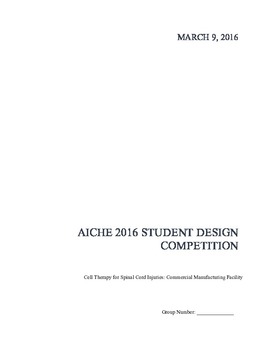| dc.contributor.author | Harrell, Grace | |
| dc.date.accessioned | 2017-10-10T20:54:23Z | |
| dc.date.available | 2017-10-10T20:54:23Z | |
| dc.date.issued | 2016-03-09 | |
| dc.identifier | oksd_harrell_HT_2016 | |
| dc.identifier.uri | https://hdl.handle.net/11244/52266 | |
| dc.description.abstract | The following contains preliminary design considerations for the large-scale production of neural stem cells for spinal cord injury regeneration therapy. The facility is designed to meet market demand for years 2017-2021 assuming there are currently 250,000 people, plus the addition of 12,000 people each year, with spinal cord injuries. In other words, 66,222 people per year can benefit from this process. Each batch process begins with 100,000 undifferentiated induced pluripotent adult stem cells and ends with approximately 2.17*10^11 differentiated neural stem cells that have gone through various measures to ensure quality. Each neural stem cell vial contains 1*10^7 cells and the breakeven price per vial was calculated to be $24.04 at a hurdle rate of 50%. The overall capital cost for the process is $871,606 with maximum recurring costs of about $7,000,000 from media, chemicals, vials, well racks, and operating costs each year. | |
| dc.description.abstract | As can be seen in the "Sensitivity Analysis" section, the selling price of the vial has a major impact on the net present value (NPV) of the project. The cost of the media also can have a major impact on the net present value as it represents a major portion of the recurring costs. Therefore, if media costs go down, the NPV of this project will go up in response. | |
| dc.description.abstract | Three or four operators are required per shift for operation depending upon the part of the process that is occurring. Most of the process is automated and at any given time, there is no more than nine of the nineteen pieces of equipment in operation and four of those are only on for a short amount of time. | |
| dc.description.abstract | Safety considerations were of the utmost importance in designing this process. The facility is designed to minimize cross contamination by separating the sterile process from the rest of the facility. All waste is pretreated before entering city sewers to prevent the spread of possible blood borne pathogens to the community. | |
| dc.description.abstract | It is recommended from the preliminary design that a detailed design be conducted as the project is a low capital investment, has a short payback period, and is very economically attractive as can be seen from the "Conclusions and Recommendations" section of the document. | |
| dc.format | application/pdf | |
| dc.language | en_US | |
| dc.rights | Copyright is held by the author who has granted the Oklahoma State University Library the non-exclusive right to share this material in its institutional repository. Contact Digital Library Services at lib-dls@okstate.edu or 405-744-9161 for the permission policy on the use, reproduction or distribution of this material. | |
| dc.title | AIChE 2016 Student Design Competition: Cell therapy for spinal cord injuries: Commercial manufacturing facility | |
| osu.filename | oksd_harrell_HT_2016.pdf | |
| osu.accesstype | Open Access | |
| dc.type.genre | Honors Thesis | |
| dc.type.material | Text | |
| thesis.degree.discipline | Chemical Engineering | |
| thesis.degree.grantor | Oklahoma State University | |
